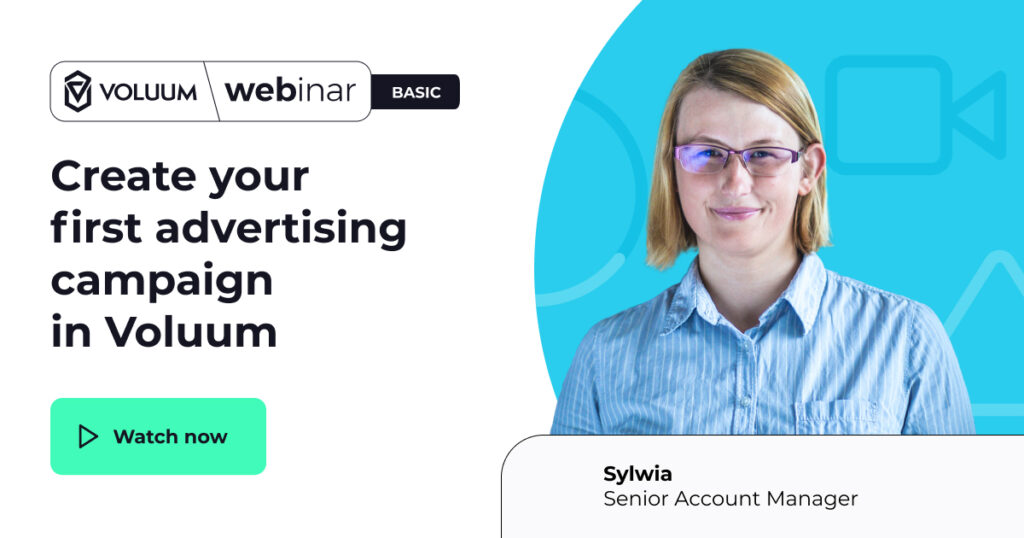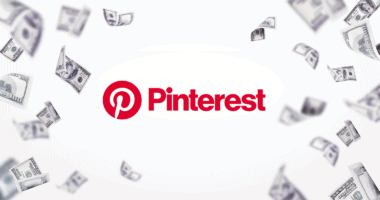Newbie or seasoned affiliate, anyone can benefit from some affiliate marketing tips. Chances are that you didn’t hear every one of them.
This article won’t explain what affiliate marketing is and how it works. If you are interested, let me recommend our free courses that will teach you the ins and outs of this industry. This article focuses only on tips for a beginner and medium-level affiliate marketer that will elevate your chances for affiliate marketing success.
Let’s jump straight to them. Here are 29 affiliate marketing tips plus 3 false myths that are still believed to be true.
The list of 29 Affiliate Marketing Tips
1. Warm up your Facebook account
You’ve probably been on Facebook for many years now. You shared many posts, liked many things. For Facebook, your personal account shows signs of natural human behavior. If you create a new account from scratch, you are a complete tabula rasa (blank slate) to them. It is good to fill that slate with normal human use.

A small digression: generally speaking, we cannot definitely say what Facebook (or other social media platforms) likes and what factors its algorithms take into account to assess your ads and you, as an advertiser. It’s not written anywhere, and not carved in stone. However, we have some indications that will probably help you in the long run.
One of the factors that seem to be important to Facebook is account scoring. If it shows the aforementioned signs of natural behavior, it is treated differently than a completely new account. The different treatment includes:


Many affiliates say that they skip this step. But if you are playing the long-term game, this may help you look more credible in Facebook’s eyes. So do as humans do:
- share things,
- get comments and likes,
- write stuff.
Once you start using your account for advertising purposes, remember that the scoring process never ends. The algorithm will assess users’ activity involving your ads, a domain that you use (.com domains are rated higher than cheap .xyz ones), compliance, and your engagement with Facebook support.
2. Consider your options: offer or affiliate marketing program
You may have often heard that the most important thing is finding a good offer. While this is true, it also suggests that offers from affiliate networks are the only thing that an affiliate marketer can advertise online.
There are also affiliate programs. These are additional sales channels for big companies that reward marketers for getting new customers. Unlike referral programs, they don’t require you to be their customer. You simply sign up for the program and promote the affiliate link. If you know the platform or the industry, you may get better results promoting an affiliate program than an unknown offer.
We have a ranking of affiliate programs from various categories for you if you want to check it out. We also have dedicated rankings and explanations of affiliate programs from popular verticals, such as:
- Crypto affiliate program
- Supplement and vitamin affiliate program
- Life insurance affiliate program
- Forex affiliate program
Affiliate programs offer several advantages over typical affiliate offers:



Note that in order to protect their brands, companies often limit the language or techniques you can use to promote their affiliate links. Many of your affiliate tricks won’t work. Consider this when deciding between affiliate programs and affiliate offers.
3. Work on your affiliate marketing strategy and decide how you want to target the audience
As Ozzy said, “Wine’s fine but whiskey’s quicker”. The same can be said about different audience types. At the beginning, you have to decide about how you are going to make people visit your affiliate marketing website.
There are three main types of audience:
- Your own audience that you can build by creating content on a blog, social media posts, groups, or video platform – this following is wine. It takes time to curate your own audience. The result is satisfying, as such an audience is ‘free’, so you don’t have to pay them with money to come to your site, only with your time spent on generating content.
- Paid traffic. For quicker results, we recommend paying for traffic. This is whisky. Results are fast, costs can be factored into your budget plan.
- There is also organic traffic (not included in the wine and whisky metaphor). It’s good to treat it as an additional option to get people to your affiliate websites, as getting the right numbers with just search engine optimization efforts is hard. Plus, with such an audience, you are at the mercy of Google’s algorithm. When they change it (and they do from time to time), you may lose your place on the SERP page.
4. Research a niche or go with evergreens
It’s always thrilling to catch the hype train and cash in on the newest craze but that’s not a requirement. You can research what’s hot but also you can go with evergreen niches and make the same money without worrying that the hot trend will die out.
To research a niche:
- Be where your audience is: join the same social groups, be on TikTok or on its inevitable replacement.
- Check popular sites on Alexa, check Google Trends and questions in Quora or popular products on Amazon and in other stores
- Talk to account managers

Evergreen niches:
- Health and beauty (increasing testosterone, child obesity, reproductive health)
- Dating (senior dating, single parents, military dating)
- Finance (women in transition, loans for veterans, medical loans)
- Sweepstakes (sweepstakes for popular products)
- Gambling (fantasy sport betting, free online poker)
- Gaming (PlayStation Store gift cards, RGB lighting, e-sport accessories)
5. Plan before you spend money
Researching a niche is one thing – you also need to research the available traffic in your traffic source. Before you commit – and by commit, I mean top up your account with a non-refundable amount of money – check if these platforms offer you the traffic you want in the volumes you need.
Most traffic sources offer a tool that is called something like ‘traffic planner’, ‘traffic estimator’, ‘calculator’ or ‘guesser’ (ok, maybe not that), and what this tool does is show you how much traffic you can expect.
It usually shows you the volume of traffic available for your targeting options.
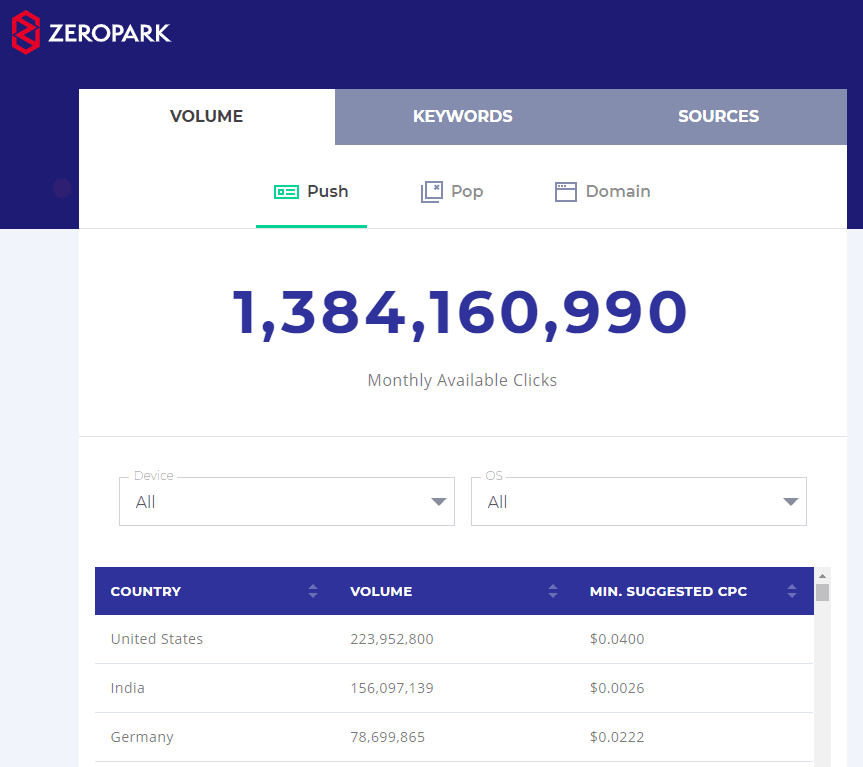
So, check if you can actually advertise your awesome offer on German traffic with this traffic source efficiently. Check other sources as well, they usually don’t vet people as hard as affiliate networks and in most cases, you can check the amount of traffic without topping up.
6. Research keywords properly
If you advertise on search engines, you should research your keywords first.
You will need to find a keyword that associates with your offer best. To do so, ask yourself some questions:
- What do people search for when they look for offers similar to mine?
- How are other similar offers marketed?
At first, you can start the keyword research on your own.


The second step would be to use professional keyword research tools. Google provides you with one. It is called Keyword Planner and it is a great way to check the volume of traffic you can expect. Another great tool is SEMrush. Apart from what Google’s Keyword Planner offers, it also allows you to spy on your competition.
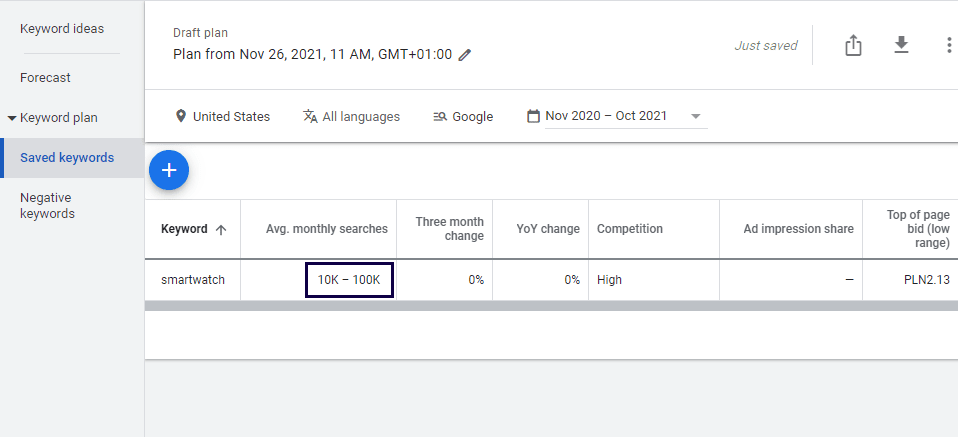
7. Plan your ecommerce campaign way before the main event
If you are aiming for a major shopping occasion with your campaign (Christmas, Black Friday, etc.), it is important to stick to this concrete schedule:
- 6 weeks before: Start preparing content, securing stock availability and planning your campaign.
- 4 – 2 weeks before: You may optionally want to launch an early deals campaign that will start to generate buzz for your affiliate sales.
- The main event: Launch your main campaign and maintain it.
- After the event: Make sure that all affiliate products have been shipped and there are no unresolved complaints.
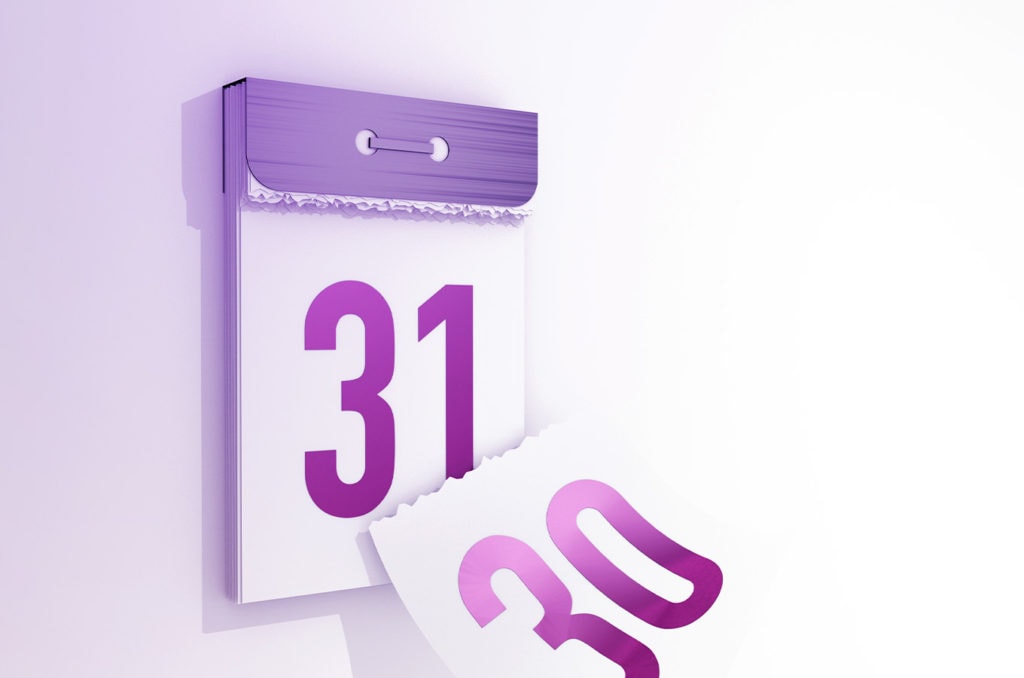
8. Go with a tracker that protects your data
Data ownership is a hot topic among marketers doing online business and the only argument for using a self-hosted tracker instead of a cloud-based one. If you are interested in the differences between those two, read our detailed comparison.
But let me tell you this: this argument becomes invalid for cloud-based trackers located in any GDPR-bound country and the hassle of setting up and maintaining your own server certainly has no merit other than partially satisfying your paranoia.
GDPR legislations put a lot of restrictions on who gets access to user data. If you are worried about this kind of thing, read more and choose Voluum, the safest tracker in the world.
9. Track and manage everything
While many affiliate ad trackers, Voluum included, allow you to track many data points down to the web browser versions, it’s rarely useful to optimize at such a granular level. You will most likely be interested in checking the performance of placements, so make sure that your tracker allows you to do the following:
- Track placements
- Manage them in bulk
- Change bids from within the tracker
- Create rules that mark or pause placements automatically
Placement optimization is the area where you can get the best results in the least amount of time. And instead of analyzing browser versions, launch another campaign.
10. Structure your affiliate campaigns in a smart way
Bad campaign structure can fog results or even make them useless. Follow the tips below to set up a campaign correctly:
- Create separate campaigns for different device types: desktop, mobile and tablet.
- Don’t put offers from different countries or verticals in the same campaign.
- If you want to test different angles, like trying more aggressive ads and landers, you should also put those in separate campaigns.
If you don’t follow these tips, you will have a hard time telling what actually worked and what didn’t.
11. Put your trust in big numbers
If at times you don’t know what to do, launch a new campaign. Affiliate marketing is mostly a game of big numbers. The point is to tip the cost vs profit balance slightly to the profit side, earn pennies on an average click and have thousands of clicks to make the whole endeavor worthwhile.
- Don’t focus on high-paying offers, they are hard to convert
- Don’t put all your hopes in one campaign
- Even the most profitable campaign can burn out without notice if an offer dies out
12. Automate and delegate
Your craft is being an affiliate marketer, put your skills into designing and optimizing campaigns instead of being a one-man orchestra and doing everything on your own:
- Outsource graphic design or page coding or go with free images or landing page builders to minimize time spent on these tasks.
- Automate basic and advanced functions in your tracker.
- Set up alerts and notifications, you don’t have to stare at your campaigns 24/7.
13. Design a ‘good enough’ ad
People are weird and the most beautiful image doesn’t always equal the most clicks. Sometimes the untypical, intriguing, low-res image may bring more traffic.
How to know which approach is better?
Test it, obviously.
But try to be consistent in your advertising: if you’re promoting a serious offer, such as a life insurance product, use ads that radiate confidence and trust. Weird may not work well but, hey, stranger things have happened in the affiliate marketing world.
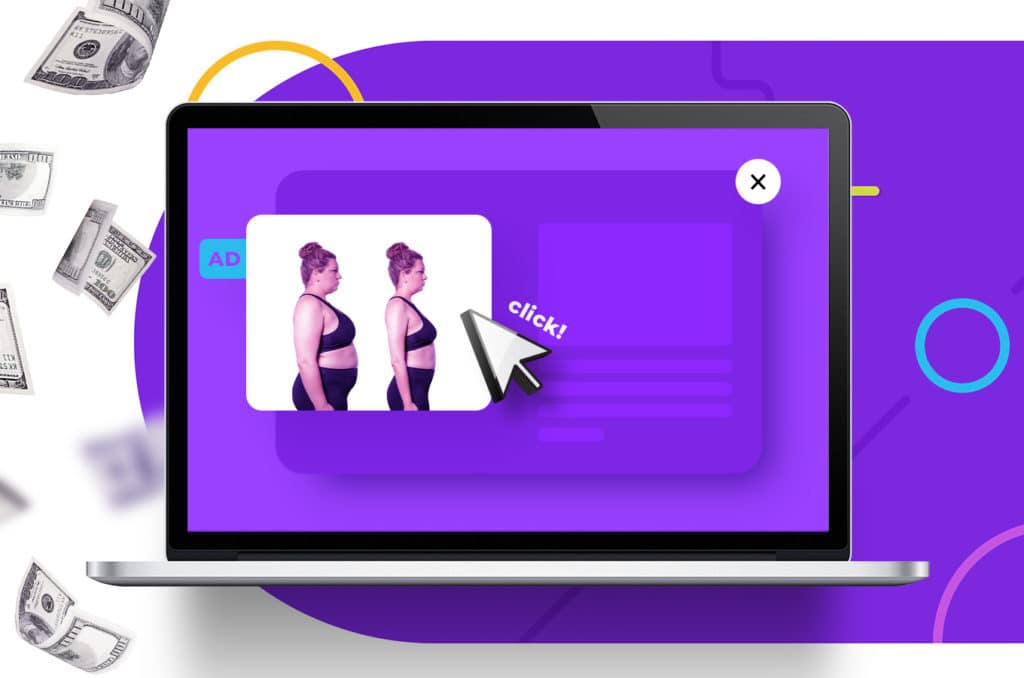
Also, design your ad with these basic principles in mind:
- Show emotions
- Show benefits of the product or people using your product rather than the product itself
- Avoid generic stock photos
- Motion blur and diagonal lines add intensity to your ads
Another tip that we should probably start with is to be compliant with a traffic source and offer owner’s requirements. The most persuasive ad is useless when the campaign gets blocked.
Lastly, to tie this tip with its title, don’t waste time designing the perfect ad. The ‘good enough’ approach works well in affiliate marketing.
You are not Google that spends millions of dollars to make pixel size changes to its logo. You can always A/B test a different variant of an ad that you think is better but don’t spend hours polishing each pixel. Your visitor will spend two seconds on the decision whether to click or not.
14. Balance traffic volume vs targeting
Remember when we praised the ‘good enough’ approach in affiliate marketing?
It works with traffic targeting too. You may be so focused on using every targeting option in your traffic source that you could miss out on a bigger portion of your traffic volume.
The rule is that the more targeted traffic is, the smaller it gets. So, our tip would be:
Stop over targeting!

There may be many potential visitors outside your targeting options.
Keep the precision of targeting balanced with the amount of traffic you get.
Tracking requires having access to a tracking domain. It may be a legacy domain that is also available for other marketers, it may also be a dedicated one, unique and accessible only for you.
Voluum offers the latter option.
The recording of the webinar that discusses this topic in detail can be found here: Avoid Cookie Block: Set Your Campaign Up for First Party Cookies
However, we still recommend getting a custom domain and setting it up both for your landing pages and for tracking. For tracking, it should be a separate subdomain. Why? Simple. This setup allows you to avoid problems with cookies.
A couple of months ago, half the Internet was filled with news about the demise of third-party cookies and the impending doom of ad tracking. This already happens on some scale (in Safari, for example), and will happen on a bigger scale probably in 2023, when Google plans to block third party cookies in Chrome.
Voluum, as well as many other affiliate tracking software, uses cookies as a backup solution to store user identifying data. The main way of passing this data is in the referrer URL, but if that data is lost on a redirect, a cookie is used. Without third party ones, the tracking would break.
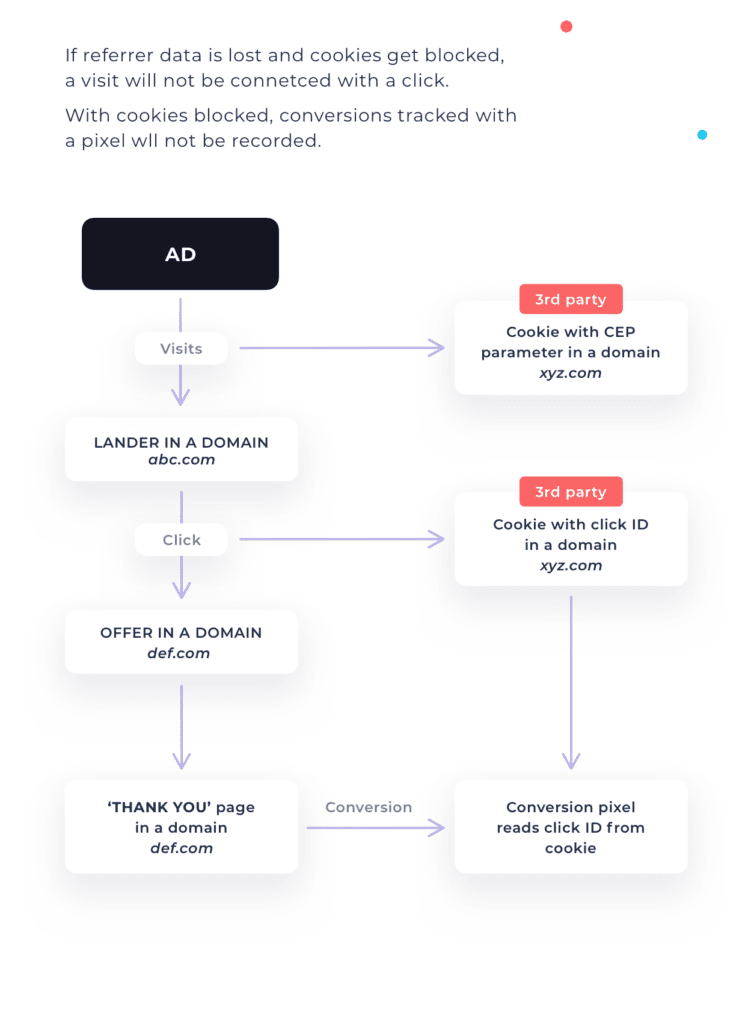
But, if you follow the setup below, the cookies set by Voluum will be treated as first party by all browsers and therefore, not blocked. Do this:
- Get a custom domain from a domain provider, for example ‘xyz.com’. For more details, visit our documentation.
- Create a tracking subdomain, for example ‘track.xyz.com’.
- Create a CNAME record for this track.xyz.com subdomain that points to the Voluum dedicated domain.
- Add the track.xyz.com subdomain as a custom domain to Voluum.
- Use your xyz.com domain with:
- (Option 1 – funnel with a landing page) your landing page and a ‘Thank You’ page, if you want to track conversions using a tracking pixel.
- (Option 2 – funnel with offer only) your offer page and a ‘Thank You’ page, if you want to track conversions using a tracking pixel.
- Create a campaign with the track.xyz.com subdomain. Use the track.xyz.com subdomain consequently in all your tracking URLs, so: campaign URL, click URL (Option 1 only), conversion tracking pixel (if you want to track conversions using a tracking pixel).
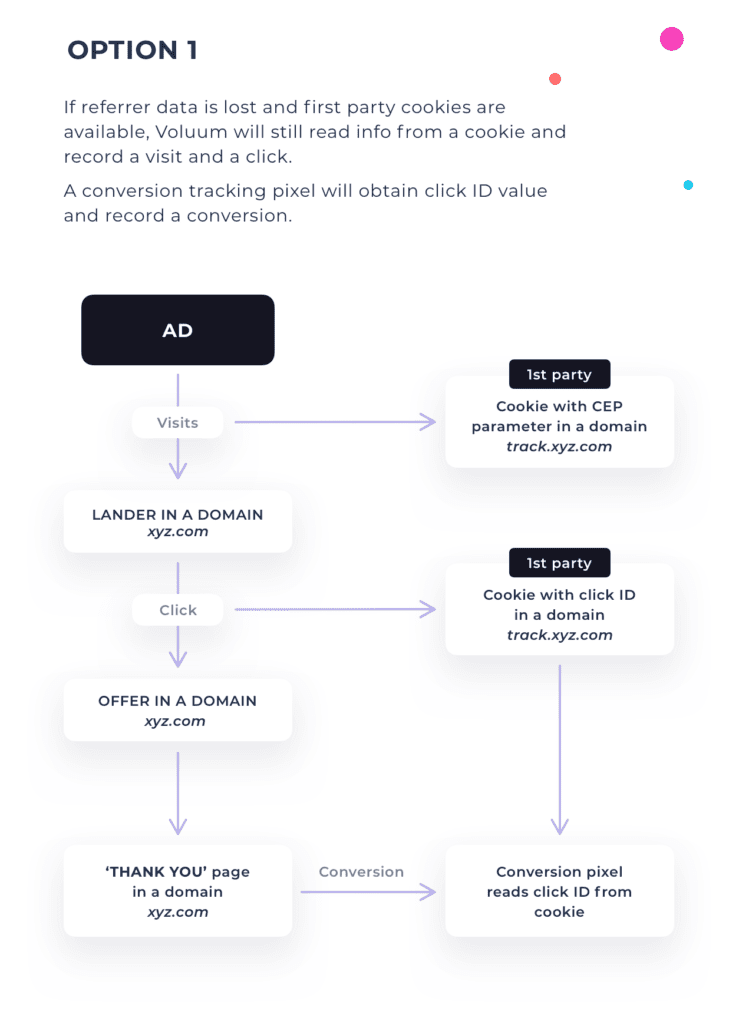
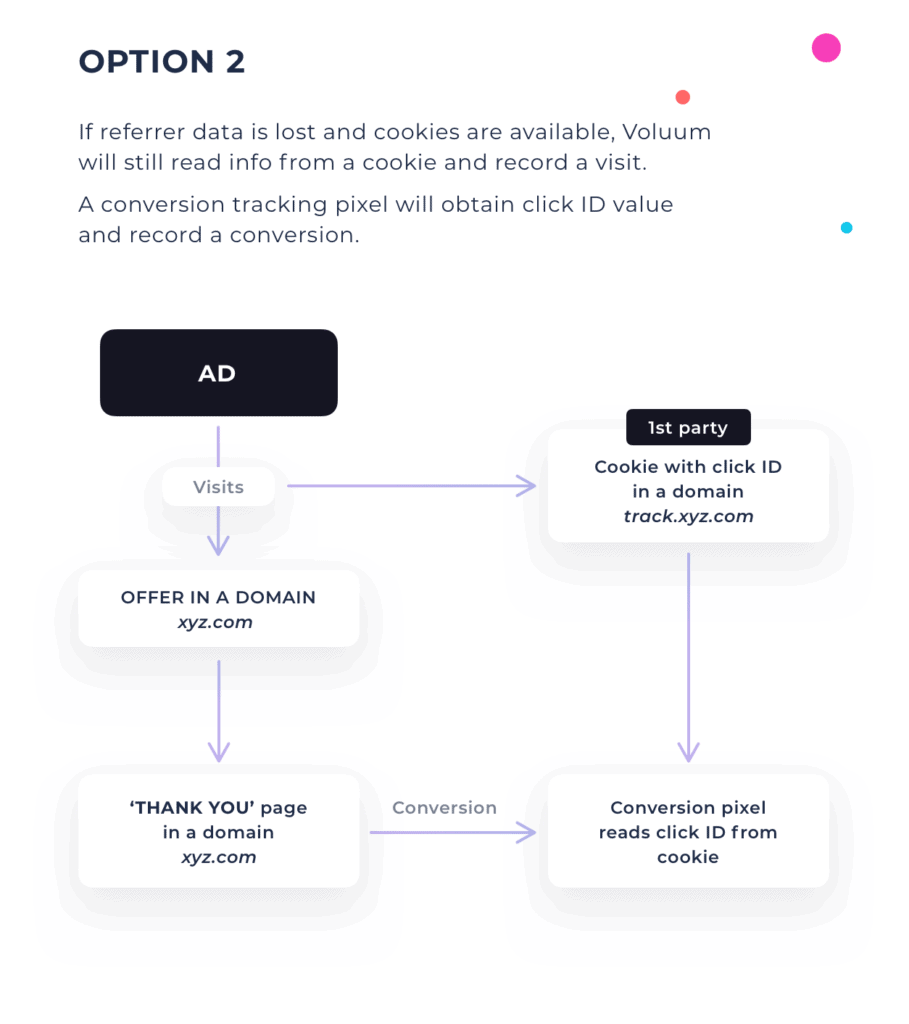
16. A/B testing vs multivariate testing
Depending on the amount of traffic you have, there are two approaches that may help you decide how to select the best:
- Offers
- Landers
- Ads
These two methods are A/B testing and multivariate testing. The difference lies in the details but briefly:


17. Experiment with different shapes of a campaign funnel
Some types of offers work better when you add additional steps between an ad and an offer. For example, you can create an advertorial landing page titled “10 best webcams for home office” and link to 10 different subsequent landing pages from this page. Such a funnel is called a ‘listicle’.
Test if direct linking is better than having a landing page, or if a landing page should point to one offer, different offers randomly, or to various offers with separate links. A/B test this approach.
18. Test the funnel
C’mon, it takes minutes.
Click your campaign funnel and follow through, plus ask your affiliate network manager to generate a test conversion for you. Some networks have the test conversion feature built into the platform, so you even don’t have to ask anybody.
Avoid mistakes such as:
- Wrong tracking domain
- Wrong URLs
- Empty spaces or misspells in tracking URLs
- Landing page not displaying correctly.
To mitigate risk of wrong setup, follow these tips apart from testing:
- Add elements with the use of templates. Trackers often have templates for popular traffic sources and affiliate networks with the correct tracking tokens. Use them to avoid typos.
- Use the API integration whenever possible. This comes with several other perks but correct setup is one of them.
19. There are always alternatives
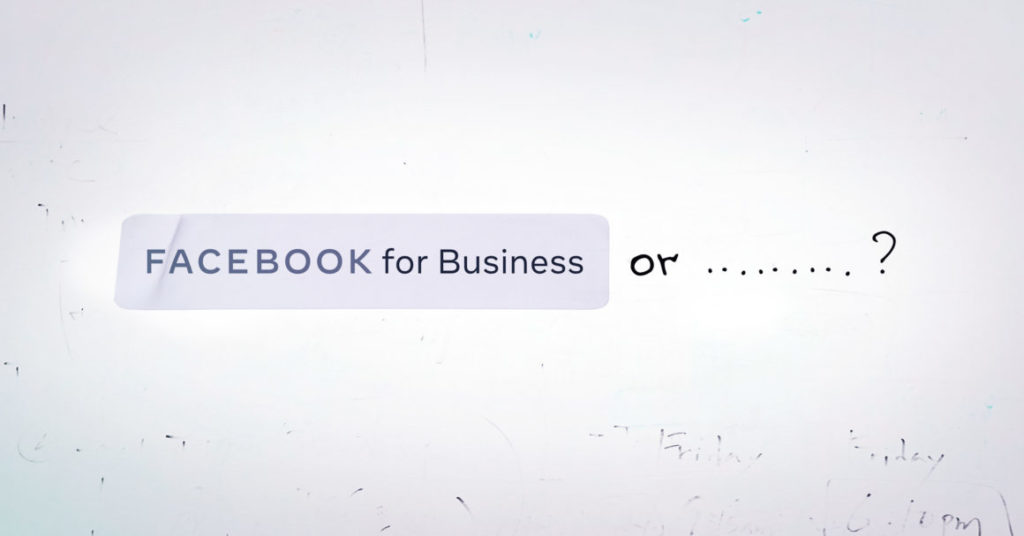
Although it may seem that Facebook and Google have eaten up most of the digital marketing landscape, there are still viable alternatives to both of these platforms. They may offer fewer targeting options and a smaller pool of visitors, but you may get



If you don’t like the advertising duo, it’s not the end of the world.
20. Follow the smart order of optimization efforts
Optimization is the effort focused on running your campaigns efficiently. But as any time-consuming process, it also has to be performed efficiently.
If you dive straight to optimizing placement, you may lose a ton of time stopping the unprofitable ones while it turns out the whole offer proves to be unprofitable. So, do the optimization in the following order:
- Stop unprofitable offers
- Stop unprofitable placements
- Adjust bids
- Adjust targeting
This is the optimal optimization process. Follow it and you will tune your campaign in warp speed.
21. Learn to love CTR
CTR is a great metric to optimize your placements, as it brings results faster. Other metrics, such as ROI or conversion rate (CR) require conversions to occur. Good CTR is usually connected with good performance of a given placement.
If a placement has spent at least double or triple of the expected payout and CTR didn’t even budge above zero, you can safely stop it.
Once you get some conversion, you can look into other metrics: ROI and CR, but CTR allows you to get rid of poor placements way sooner.
22. Adjust bidding strategy

Finding the right price for traffic is hard. Starting with the definition of the ‘right’ price.
You know that you are paying the right amount for traffic when you’re winning all auctions (so your win ratio is 100%) but lowering the bid even slightly would result in lowering the win ratio.
To achieve that, the general bid optimization rules are:


Note that you can bid on a campaign level and, in many sources, on placement level as well. Use that to maneuver your bidding strategy more precisely.
In Voluum, you can do this without ever leaving the tracker for API integrated traffic sources. And again, this is also something that you can automate with Rules.
23. Give bonuses to your customers
Ecommerce gives you a lot of options to persuade or remarket your audience.
Don’t miss on the opportunities that lay in front of your ecommerce funnels. You can not only offer additional bonuses with exit popups and ask for feedback, but also propose different offers using the email address that the customers provided during the purchase. Follow these tips:
- Save your bonus on exit popups
- Ask your customers for testimonials in exchange for some goodies
- Use their email address to present them with a new offer
- Reward customer loyalty
Apart from this, there are still some things you can do to optimize your checkout experience:
- Offer a guest purchase option. Don’t require creating a new account
- Include all costs from start: product, shipment, and taxes
- Show stock availability
- Tell customers about your return policy.
Be honest and you will be rewarded with customer’s trust. And their money.
24. Bots are a problem but you are not defenseless
If you’re telling yourself that your campaigns have failed because of bots, you are most likely kidding yourself. Bots do:



But rarely are they the sole reason for drowning a campaign. Bots are a manageable problem, so manage them.
The recording of the webinar that discusses the topic of bots and fraud can be found here: Bot Traffic is After Your Money!
On a small scale
You don’t need a fancy anti-fraud solution straight away. Carefully examining tracker stats and looking for anomalies is enough. These anomalies include:
- Sudden increase in traffic
- Unusually high CTR with low conversion rate
- Traffic coming from countries that you do not target
On a bigger scale
A dedicated tool may come in handy if you have more traffic. For example, Voluum offers the Anti-Fraud Kit that allows you to measure traffic characteristics that usually accompany bot traffic. It also allows you to block certain IPs or IP ranges and even set up a bot trap on your landing pages.
25. Keep track of all campaigns in one place
It’s essential to have all data in one place. Ad trackers are best for recording events for web traffic but recording other channels such as offline sales and in-app mobile conversion is a challenge.
Voluum works closely with a popular mobile attribution tool, AppsFlyer, to enable in-app tracking on iOS 14.5 and higher devices.
Long story short, Voluum no longer needs a click ID (that identifies concrete visits and clicks) to record a conversion. It can use a workaround and use the campaign ID to attribute a conversion from AppsFlyer.
This feature comes with other use cases as well. Postbacks with no click ID allow you to record offline sales that occur in a brick-and-mortar store, for example.
Only by having all data tracked and presented in one platform can you make data-driven decisions.
26. Be on the lookout for new types of traffic
A couple of years ago push traffic was a novelty. I know, I know, time flies. Nowadays, push is placed among other major ad types, such as display or native.
The point of this affiliate marketing tip: new opportunities to advertise your content emerge from time to time.
For example, why aren’t you advertising using injection traffic? You don’t know it exists? Exactly.
Imagine being the first person to use push notifications to advertise a product. How persuasive it must have been for the first user that saw that ad.
27. Socialize
The best blog article or webinar will never replace an expert that can give you personalized insights. Talk to people on forums or social media groups, learn from them, gain confidence.

Here are some examples:
The last part is important, as talking to people may get you that boost of confidence that you may need – more than any optimization trick.
Remember, many affiliate marketers and even superaffiliates started with a simple and unprofitable campaign. It helps to talk and vocalize your emotions.
28. Manage your budget
Let’s start with changing your attitude towards spending money on traffic.
Whenever people don’t see immediate profits, they think of bought traffic as a loss. This is very short-sighted. In business, there are many costs that seem to be useless but may bring profits in the long term.
For example, spending money on charity or for bettering the local community. The warmed brand perception is hard to measure but in many cases it may bring more overall profit than a standard billboard campaign.
Think of the money spent on traffic as an investment. Or better yet, as a purchase.
What are you buying apart from cold traffic?
Data, of course.
A click that did not result in a conversion brings as much information to a skilled marketer as a click that brought a conversion. The money you spend on traffic goes towards:
- Testing creatives, landing pages and offers
- Building blacklists or whitelists of bad and good placements
- Adjusting your traffic targeting settings
- Tuning your automated rules
This being said, we never recommend spending a penny more than what you can comfortably lose.


Luckily, this article is free.
29. Explore other ways of making more money in affiliate marketing
You will make more money and feel better while doing so when you leverage up your skills and your unique knowledge of a given part of the industry in a concrete niche. Not like a marketing niche, but a niche in the affiliate marketing world for you, as a specialist.
Instead of promoting someone else’s product online, you can also:
- Build your own partnership network. If you work with affiliate partners or influencers that you want to manage
- Traffic arbitrage. This is when you have access to cheap traffic and want to resell it at a higher price.
Both options can be handled with Voluum.
Myths that are still believed to be true
The above tips have been proven to work through the expertise of thousands. However, not every affiliate marketing tip is pure gold. Here are three myths that were (and still are) often repeated but should be avoided.
Myth 1: New technologies will soon revolutionize advertising
This is the revolution that is trying to happen but cannot. Much like the green revolution. Many technological advances were supposed to change the way people experience ads and interact with the online world. Very few of these gimmicks made an impact.
We were told multiple times that voice search is on the rise (it is) and it will change marketing (it didn’t). It’s easy to scroll down the SERP page, past the paid ads. It wouldn’t be so easy to listen to ads being slowly said by the virtual assistant of your choice.
VR is still a niche thing for passionate gadget collectors. Facebook rebranding itself as Meta may indicate the company’s insight into the future, as well as maybe a sign of their confusion and uncertainty.
The COVID-19 pandemic was the best opportunity for VR to catch on. People stuck inside with no other option than the virtual environment to get out. If the pandemic didn’t help VR get some traction, nothing will in the near future.

For now, there are no VR ads next to push, banners and natives.
It’s easy to be swept up by the promises of tomorrow, but here and now we still have banners or push ads to keep our businesses alive.
Myth 2: Redirect speed is the most important
In 2021 marketers are still afraid that redirects take a lot of time and increase bounce rate.
The truth is that, outside regions with very poor Internet connections, this ‘problem’ is non-existent. Tips telling you to switch to a direct method of tracking because it is faster are, ironically, not worth your time.
The direct method of tracking has a justification: it is compliant with many traffic source’s requirements (hey, a bonus tip for you!) such as Google or Facebook, but redirect speed is not an argument.
Myth 3: Affiliate marketing is easy
There was a surge of newcomers during the pandemic. People that have lost their source of income often turn their attention to the online world, following the promises that there is money just laying around on the digital streets, ready to be picked up. Passive income at hand.
We, as a notable part of the digital marketing landscape, are always happy when we see new people joining the community. But we want to make one thing clear: it takes some effort to pick up that money. You have to invest some time, cash, and be ready to learn new things.
Affiliate marketing is not easy but still easier than most other businesses. It’s not susceptible to lockdowns, it doesn’t require you to rent a venue or buy any equipment other than a laptop and a coffee machine (it’s essential, trust us!).
We don’t want to sugarcoat it. We really want affiliate marketers to succeed. It’s both a matter of satisfaction and our interest. So, the tip would be: if you put your mind and resources to it, you can make affiliate marketing happen.
One last point: Theory instead of practice
We’re kind of undermining ourselves here but hear us out: it’s good to read some articles, watch videos and participate in webinars. But you cannot theorize your path to success – you have to launch a campaign first, watch this campaign fail, try again and improve. It’s not like there’s a point where you read enough content that you will know everything and your first campaign and every subsequent one will be a hit.
I’m glad that you’ve read so far, few people did, but now is the time to put these affiliate marketing tips and the theory from all other blogs that you have read into practice.


